Caring For Your Roses
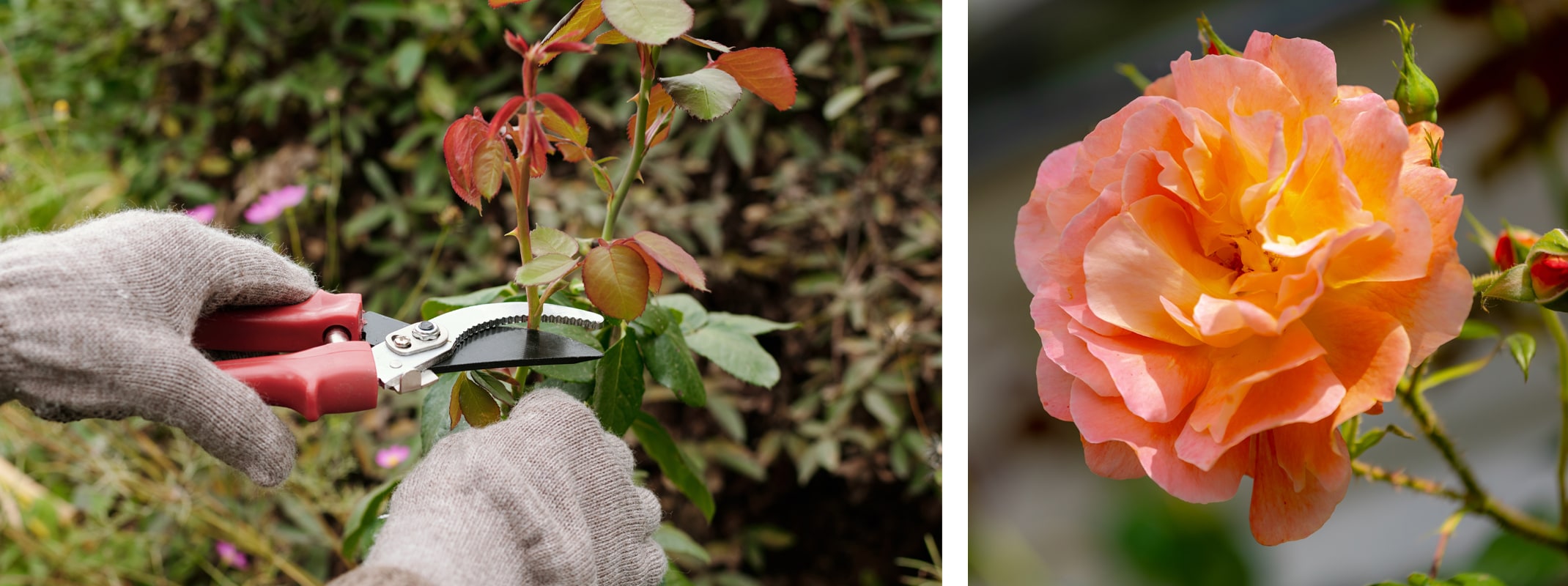
6 Steps to Caring for Your Roses During the Dormant Season
Pruning during dormancy is essential for stimulating healthy growth. The more you prune, the more robust the new growth will be. After performing heavy dormant pruning, follow up with light pruning in March to control new growth and shape the shrub.
1. It All Starts with The Right Tools and Sanitation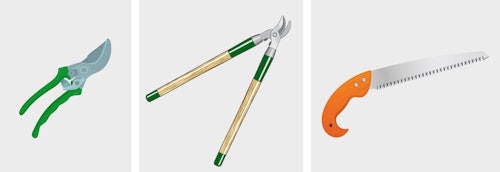
To properly prune your roses, you'll need the right tools:
- Bypass Pruners: Perfect for cutting limbs of 1/2" diameter or smaller.
- Loppers: For cuts larger than 1/2" diameter.
- Pruning Saw: For very large cuts on older rose shrubs with thicker canes.
Keep your tools sharp and clean to ensure clean cuts and minimize the risk of spreading disease. Use a 10% bleach solution or rubbing alcohol to sanitize your tools between cuts, especially after cutting diseased areas. Never set your tools on the ground to prevent contamination.
2. Pruning Your Roses
Here’s the proper technique to follow when pruning your roses: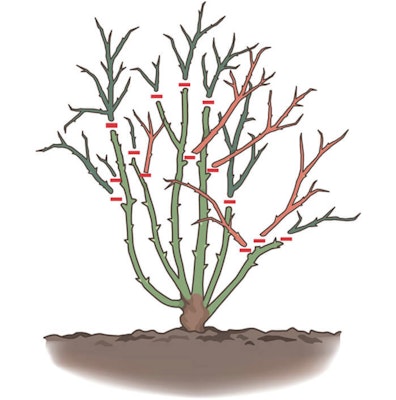
- Remove Dead or Damaged Wood: These areas are magnets for pests and disease.
- Cut Off Suckers: Remove any suckers growing from the roots, as these won't match the rest of the plant.
- Trim Spindly or Old Growth: Canes thinner than a pencil aren't strong enough to support healthy growth. Thick, old canes are no longer vigorous.
- Remove Rubbing Canes: Any canes that rub against each other should be removed to prevent injury, which could allow pests and disease to enter.
- Make the Right Cut: For canes you plan to keep, make a 45-degree angle cut above an outward-facing bud. This encourages outward growth and reduces the risk of disease.
- Remove Leaves: Strip the remaining leaves from the plant to eliminate places where insects could overwinter.
After pruning, apply a 2” layer of organic compost followed by 1” of mulch to control weeds and retain moisture.
3. Clear The Area
It’s important to clear away any pruned material or leaf litter under your roses. Fallen debris creates a breeding ground for pests and diseases, so remove it to help maintain plant health.
4. Protect Your Roses

 Consider applying a copper-based fungicide like Bonide Copper Fungicide or Monterey Liqui-Cop to protect against diseases such as powdery mildew, leaf spot, and rust. Apply the fungicide early in the morning when it’s neither wet nor windy. Always spray before buds begin to swell.
Consider applying a copper-based fungicide like Bonide Copper Fungicide or Monterey Liqui-Cop to protect against diseases such as powdery mildew, leaf spot, and rust. Apply the fungicide early in the morning when it’s neither wet nor windy. Always spray before buds begin to swell.
Spray Tips: Apply on New Year's Day and/or Valentine’s Day, thoroughly coating all surfaces to protect against overwintering pests and diseases. Be sure to spray before bud break.
 Bonide Rose Rx 4-in-1 - is a versatile solution designed to protect your roses from pests and diseases. Acting as a fungicide, insecticide, miticide, and nematicide, it helps control a wide range of garden pests while preventing fungal issues like black spot and powdery mildew. This all-in-one treatment ensures that your roses stay healthy and free from damaging pests and diseases, keeping them vibrant throughout the growing season.
Bonide Rose Rx 4-in-1 - is a versatile solution designed to protect your roses from pests and diseases. Acting as a fungicide, insecticide, miticide, and nematicide, it helps control a wide range of garden pests while preventing fungal issues like black spot and powdery mildew. This all-in-one treatment ensures that your roses stay healthy and free from damaging pests and diseases, keeping them vibrant throughout the growing season.
5. Fertilize and Amend
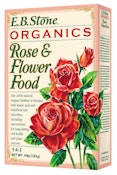 E.B. Stone Rose and Flower Food - is a specially designed fertilizer that promotes strong growth and vibrant blooms in roses. It provides a balanced mix of essential nutrients like nitrogen, phosphorus, and potassium, supporting healthy foliage and abundant flowers. The fertilizer also includes natural ingredients that improve soil health and encourage root development, ensuring your roses thrive throughout the growing season.
E.B. Stone Rose and Flower Food - is a specially designed fertilizer that promotes strong growth and vibrant blooms in roses. It provides a balanced mix of essential nutrients like nitrogen, phosphorus, and potassium, supporting healthy foliage and abundant flowers. The fertilizer also includes natural ingredients that improve soil health and encourage root development, ensuring your roses thrive throughout the growing season. Osmocote Outdoor & Indoor Slow Release Plant Food - is a convenient fertilizer that provides roses with essential nutrients over an extended period. Its slow-release formula ensures a steady supply of nutrients, promoting strong growth, healthy foliage, and vibrant blooms. This fertilizer is designed for both indoor and outdoor plants, making it ideal for roses, and it helps improve overall plant health by feeding them gradually, reducing the risk of over-fertilization.
Osmocote Outdoor & Indoor Slow Release Plant Food - is a convenient fertilizer that provides roses with essential nutrients over an extended period. Its slow-release formula ensures a steady supply of nutrients, promoting strong growth, healthy foliage, and vibrant blooms. This fertilizer is designed for both indoor and outdoor plants, making it ideal for roses, and it helps improve overall plant health by feeding them gradually, reducing the risk of over-fertilization.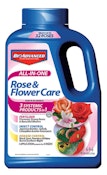 Bayer Advanced All-in-One Rose and Flower Care - is a comprehensive fertilizer that not only nourishes roses but also protects them from pests and diseases. It provides essential nutrients for healthy growth and vibrant blooms, while also helping control common rose problems like black spot, aphids, and Japanese beetles. This all-in-one solution simplifies rose care by combining feeding, pest control, and disease prevention in one easy-to-use product.
Bayer Advanced All-in-One Rose and Flower Care - is a comprehensive fertilizer that not only nourishes roses but also protects them from pests and diseases. It provides essential nutrients for healthy growth and vibrant blooms, while also helping control common rose problems like black spot, aphids, and Japanese beetles. This all-in-one solution simplifies rose care by combining feeding, pest control, and disease prevention in one easy-to-use product.
Fertilizing in the dormant season helps prepare your roses for strong growth come spring.
6. Maintenance of Tools
Regular maintenance of your pruning tools is critical to making clean cuts. Clean your tools after each use, and for stubborn sap buildup, disassemble the pruners and scrub them with warm soapy water. To keep your tools sharp, consider using a sharpening tool or taking them to a professional. Lubricate the central joint to maintain smooth cutting action.
A leather scabbard for your pruners keeps them accessible and protected from contaminants.
By following these steps, you can ensure your roses are healthy and ready to bloom beautifully. Proper dormant season care will not only help with growth but also protect your plants from disease, giving you vibrant, lush roses in the spring!
Rose Selection
